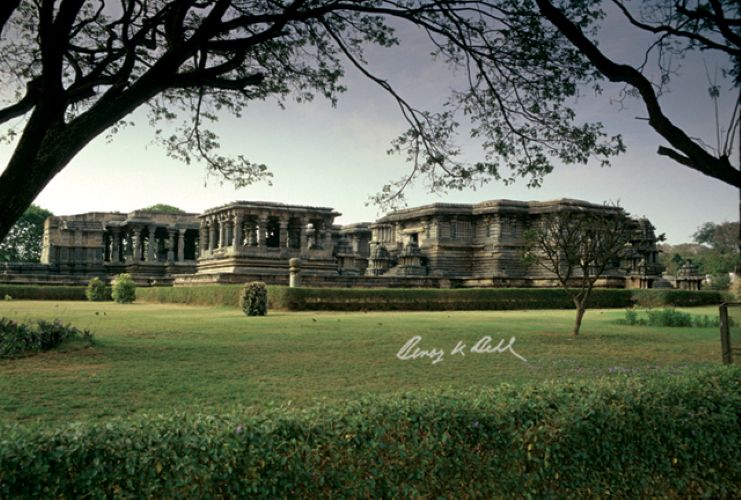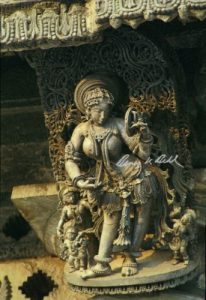Filigree in Stone: Hoysala Temples

Halebid, Hoysalesvara Temple Complex
Benoy K Behl
King Vishnuvardhana defeated the imperial Cholas in 1116. This was a landmark in the establishment of his dynasty the Hoysalas. To commemorate his victory, he built the Temple of Keshava or Chennakeshava at Belur, in present-day Karnataka. He named it the Vijayanarayana or the Victorious Vishnu.
The temple is a classic example of the ornate style of temple art under the Hoysalas. They inherited a rich tradition of temple building from the dynasties before them, the Chalukyas and the Cholas.
The exterior of the temple is more profusely sculpted than ever before, in a manner which has come to be known as the ornate Hoysala style. Horizontal rows of carvings run around the structure in an ordered and highly organized design. Every inch of wall surface is sculpted, often in miniaturized detail.
The temple has the richest surface texture seen in any in India. The bands of carving which go around the temple run for over 700 feet. The elephants we see below number about two thousand.
The exterior walls present the world of forms- the material universe we perceive around us. Here, at the temple, the world is seen in its true perspective. It is seen as a manifestation of the truth beyond, which is in the garbha-griha, or womb-chamber, deep inside the temple.
The Hoysala artist paid the greatest attention to detail. Every limb of each figure, every decorative design shows this preoccupation. There appears to be a limitless devotion and time which the sculptor must have put into his laborious work. Every unit of work is remarkable in its intricacy of design, depth of detail and skillful craftsmanship.
The figures and decorative motifs are deeply undercut and stand out most effectively against dark shadows. The best-known sculptures here are of the Madanakais, the bracket figures, beneath the overhanging roof of the mandapa. Bracket figures are also a theme which continue from the art of the western Chalukyas of the Deccan. These are Nayikas, or beautiful women, who are seen in Indic art from early times. They represent the fertile abundance of nature. The fullness of the figures and ornamentation is somewhat similar to the idiom of nearby Kerala.
Chennakeshava Temple (woman with mirror).
Pic. Benoy K Behl
The sculptures are a celebration of beauty. The depiction of youthful maidens is considered by medieval texts to be an essential ornament of temples. This is a celebration of the beauty and possibilities of the human form, which is here imaged as divine.
To create the images in such detail, the artists used an appropriate stone. When quarried, chloritic schist is extremely soft and easy to cut. It becomes harder and long-lasting with exposure to air over a period of time. The softness of the stone made it possible for the sculptor to chisel the minutest details.
Many finely carved temples stand in the present-day village of Halebid, which was the grand capital of the Hoysalas, known then as Dorasamudra. Built between 1121 and 1160, the profusely-decorated temple of Hoysaleshvara is the most prominent structure here. In the words of historian Percy Brown, it is “without exaggeration, one of the most remarkable monuments ever produced by the hand of man”.
The exterior of the temple, as in other Indic temples, provides a view of the world of separated forms that we perceive around us. Here, they are seen as a manifestation of the deity, enshrined in the garbha griha.
The region had a tradition of ivory and sandalwood carving, which continues till today. Hoysala sculpture was probably influenced by this form of miniature art.
The Keshava temple at Somnathpur was made in 1268. The Vimana of the temple survives and gives us an idea of how the modest-sized towers of Hoysala times would have looked. Rather than impressive height, the emphasis remains on profuse sculptural decoration.
The Hoysala temples mark one of the most exuberant periods of Indian art. The artists of this time must have been among the most assiduous in their detailed work and most prolific in their output. It is the stylization in Indian art which is marked here, with less of the naturalism which was also seen before. While every fingernail is carved, the breath of life, which animates much of Indian sculpture, has given way to profuse ornamentation. An ornamentation which displays the grandeur of the Hoysala court and empire.
Under the Glimpses of Culture series, India Habitat Centre presents an online talk and
screening of the film ‘The Roof of the World’ ((Early Monasteries of the trans-Himalayas)
produced by Benoy K Behl for Doordarshan on May 10, 6pm. Click here to join


